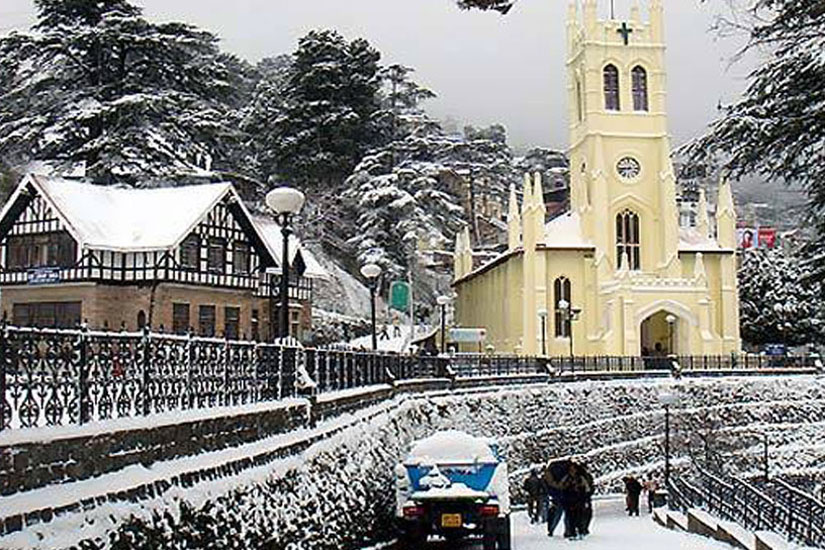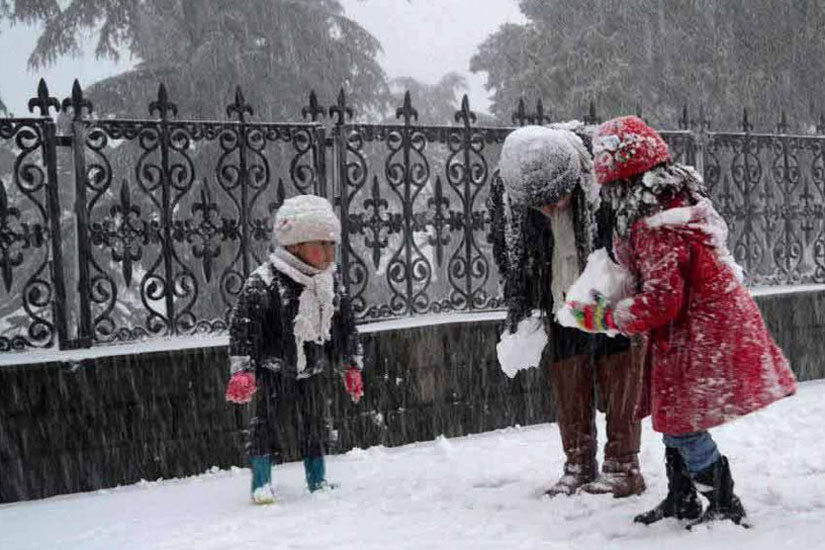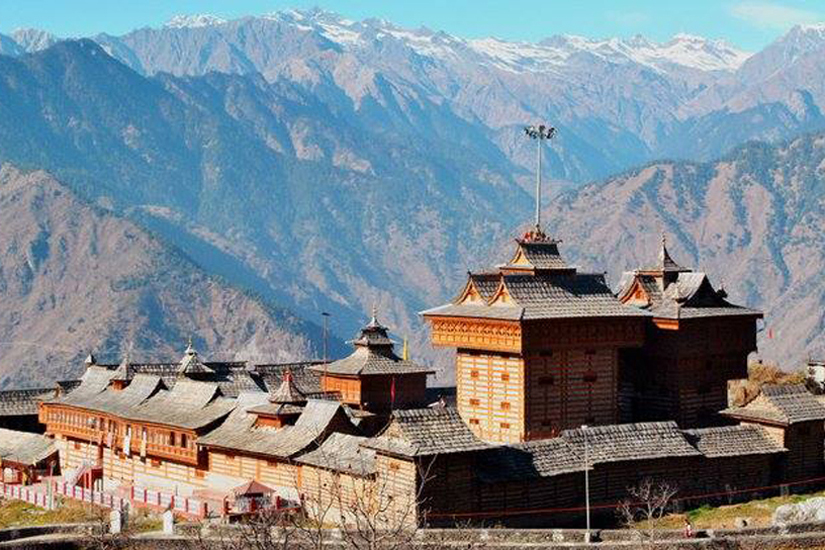With all its intricacies, history seems to have been the mortar for every brick and stone that has
built Shimla. As the summer capital of British India for well over a century it was the seat of one of the most powerful governments
in the world. From its cedar-shaded heights, one fifth of the human race was ruled and the decisions made those decades ago affect
our lives to the present day.
The town of Shimla rose in the nineteenth century when the Gurkha Wars came to an end in 1815-16
and the victorious British decided to retain certain pockets as military outposts and sanitaria. In 1822 the most rigorous of dandies
and the
greatest of sticklers for form Captain Charles Pratt Kennedy, Political Agent to the Hill States directed that a house be built for
him at the village whose name is variously reported as Sheyamalaya Shumlah, Shimlu and Shemlah. Kennedy House led the vanguard of
the hundred-odd houses that were to scatter themselves by 1841 over every level or gently inclining space. Lured by the climate
and terrain scores of European invalids began moving to the station and the only stipulation of the local chief who owned the
land was that no tree be cut or cattle slaughtered.
In 1864 the Viceroy, John Lawrence anointed Shimla – then spelt Simla, as the
summer
capital of British India.
Places for INTERSECT
The Ridge
The large open space in the heart of town presents excellent view of the mountain ranges.
The Mall
This is the hub of Shimla’s social life. Lined by shops and restaurants this pedestrian thoroughfare loosely resembles an English Home County’s marketplace. The Gaiety Theatre, which is a reproduction of an old British theatre is a center of cultural activities. A passenger lift operated by HPTDC can be taken from the Cart Road to The Mall. Lakkar Bazaar adjacent to the Ridge is popular for its wood crafts and souvenirs.
Kali Bari Temple
Few yards from scandal Point towards General Post Office. It is believed that the idol of Goddess Shayamla is enshrined there.
Jakhoo Temple
Two km from city centre, this is Shimla’s highest point and offers a panoramic view of the town’s hills
and distant mountain ranges. There are spectacular views at sunrise and sunset especially during the monsoons. The peak has a temple
dedicated to Lord Hanuman. Legend has it that he stopped here while searching for the sanjivini plant – the herb required to cure
Laxman who lay mortally wounded on a battlefield in Lanka in an episode from the epic Ramayana. A variation of the legend says that
his sandal fell here. The temple has been exhaustively renovated and this vantage point is being connected by a ropeway. At the top
of the hill in the temple complex a 108 feet tall idol of Lord Hanuman is a big attraction for the tourists.
The way to the
temple is, on foot, from the Ridge near Christ Church. Other option is to hire pony from the Ridge or drive taking via the Cart Road.
State Museum
The State Museum lies atop mount pleasant in a house called 'Inverarm'. It has a rich display of the state's cultural, artistic and archaeological heritage, ancient historical sculptors and paintings of Himachal Pradesh. Visiting hours 10 AM to 5 PM. Closed on Monday and gazetted holidays.
Indian Institute of Advanced Study - Viceregal Lodge
3 km away, IIAS is housed in the former Viceregal Lodge. Built in 1988 this is a spectacular English renaissance-inspired grey-stone structure with superb Burma teak woodwork on the interiors. It is surrounded by magnificent grounds and also has a small museum.
Narkanda
Narkanda offers spectacular views of snow ranges. An uphill trek through Deodar woods leads to Hatu Peak (8 Km). Ancient temple of Hatu Mata is alive with skiers. HPTDC runs Hotel Hatu and in winters short skiing courses are organised.
Rampur
Once the capital of the Princely State of Bushahr, the town is situated on the banks of Satluj river, Big Commercial Centre and famous International Lavi fare which is held in November every year, Dumgir Buddhist Temple, Padam Palace, Raghunath Temple, Ayodhya temple and Narsingh Temple, are worth visiting. Himachal Tourism runs a tourist Complex and air conditioned Cafe, Satluj.
Sarahan
from Jeori Sarahan is (17 Km) with spectacular view of Srikhand range. Sarahan has the majestic Bhimkali Temple. Himachal Tourism runs Hotel Shrikhand. Saharan is the gateway to Kinnaur. A Pheasant Breading Centre and stadium are worth visiting.
Mashobra
Motorable on Shimla-Naldehra road. Surrounded by thick forests and offers ideal walks. Goddess Durga temple is worth seeing.
Naldehra
23 km away from Shimla, at 2044 m this has a thick cedar forest, picnic grounds and a nine-hole par 68 Golf course that is regarded as one of the most challenging in the country. In the repeat nine there are four additional greens and different tees, which increase the yardage in the second round. This was designed by the British Viceroy of India, Lord Curzon and he was so enchanted by the spot that he often camped here for days on end communicating with Viceregal Lodge by means of a heliograph. He even named his daughter after the place.
Tattapani
Shimla-Mandi Highway via Naldehra. Tattapani has hot water springs having sulpher contents, also Hindu temples and Shiv Goofa at Saraur (4 Km) are worth seeing places
Chail
Chail was the summer capital of the former princely state of Patiala. It came into being in the late nineteenth century when it’s handsome and dashing Maharaja Bhupender Singh was banished from Shimla, the summer capital of British India for a dalliance with the British Commander –in-Chief’s daughter. Smarting at this insult, Bhupender Singh began exploring the neighbouring hills with a single guiding force – to find a hill that was within sight of Shimla but higher. The little village of Chail seemed perfect. Shimla lay within direct vision, and most important, Chail was higher than the British controlled Shimla town. Large tracts of the land here already belonged to him. This had been given to his ancestors for services rendered during the Gurkha wars which had come to an end in 1815-16. A site was selected and the Maharaja began building his summer palace. But an ill omen seemed to hang over the construction area. Local legend has it that the moment anything was built, it would collapse over night. Dozens of snakes would appear from nowhere and attack the labourers. Then Bhupinder Singh had a dream. A sage appeared before him and declared that the site the Maharaja had chosen was where he had meditated till he was taken by the earth, and his peace should not be disturbed. The Maharaja had the sage’s blessing to build on any other spot. Bhupinder Singh moved to another site and at the original spot – which is about a kilometre from the Palace Hotel – he had a temple built to the sage. Here the stone embodiment of the sage may still be seen along with the iron tongs and trident. The shrine is known as the Sidh Baba Ka Mandir and is revered by many who claim that the sage has the power to grant boons. Meanwhile Bhupinder Singh had another site levelled out and a splended mansion was built and sumptuously furnished. And at 2226 m, a good hundered meters above Shimla’s average height, Bhupinder Singh’s summer capital was prepared to taken on the British one at equal terms.



